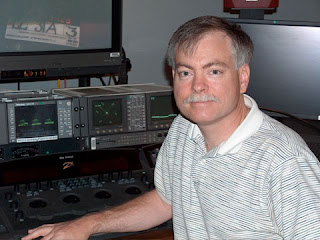Sunday, January 17, 2010
Searching For A CRT Replacement Part 2 of 2
I had an ISF (Image Science Foundation - www.imagingscience.com) certified technician drop by and do a calibration on the plasma and it easily calibrated to D65 or television white. We ran a series of test signals that revealed good black to white tracking but a video processor was needed as the plasma displays a wider gamut than Rec 709. The tech recommended a Lumagen (www.lumagen.com) processor. I spoke with the sales manager there and got a very good overview of the unit. I have to say I've never heard of the unit and understand it's a quality unit known to the home theatre industry. There trying to make themselves know in broadcast so check them out. When I was at NAB last year I saw the new line of Cine-tal Monitors (www.cine-tal.com) and their video processor Davio. I recently borrowed a demo unit from our local reseller and took it through it's paces. Davio works in conjunction with cineSpace software and an X-Rite probe (www.xrite.com) to profile the plasma panel, create a LUT and display it. When I did a Digital Colour Theory class at FXPHD.com I had spoken the Jeremy Pollard when he was at Rising Sun Research/Cine-tal. He walked me through the software and I spoke of it in the class and used it to profile a Dell LCD display that I was using at the time. It did a nice job sampling the grey scale at over 4000 points and adjusting the Primaries for Rec 709. I'm using the Davio now and Cine-Tal's Richard Schott was a great help in dialing it in. Excellent pictures now and Rec 709.
Saturday, January 9, 2010
Searching For A CRT Replacement Part 1 0f 2
Hi,
I've started my freelance business and was looking for a grading monitor to do my colour correction with. I started my search by going to one of the mailing list I read, the Cinematography Mailing List. A noted Digital Imaging Technician named Tom Tcimpidis had mentioned he was using a Panasonic pro plasma, on set, and the images looked sweet. Tom is well known in the industry and of the 100 or so e-mails I get from 5 or 6 mailing lists I check his. Plasmas have similar colour characteristics as a CRT, the viewing angle is great, response time is super fast and that means no lag. Plasma blacks are black.
The companies I've worked for over the years had 19" monitors and when I started looking at plasmas the size ranged from 42 to 60 inch. There's nothing cooler than seeing your images on a big screen. When you have a big monitor of say 50 inches you have to have a big room so your sitting back at least 15 feet. Otherwise you can't see what's going on either size of the screen.
I picked up the 50", for the wow factor, and read all I could from Panasonic about commissioning it. It seems you have to burn the panel in so I connected a 100% white signal to it and let it cook for a full week 200 hours. This seasons the phosphors and helps reduce burn-ins from leaving an image on the panel for a long period of time. A new plasma drifts until the burn in has ben completed.
Once the burn-in was completed i started looking at some test signal and images and wow between the size of the screen and the fantastic colour it was amazing. More next time.
I've started my freelance business and was looking for a grading monitor to do my colour correction with. I started my search by going to one of the mailing list I read, the Cinematography Mailing List. A noted Digital Imaging Technician named Tom Tcimpidis had mentioned he was using a Panasonic pro plasma, on set, and the images looked sweet. Tom is well known in the industry and of the 100 or so e-mails I get from 5 or 6 mailing lists I check his. Plasmas have similar colour characteristics as a CRT, the viewing angle is great, response time is super fast and that means no lag. Plasma blacks are black.
The companies I've worked for over the years had 19" monitors and when I started looking at plasmas the size ranged from 42 to 60 inch. There's nothing cooler than seeing your images on a big screen. When you have a big monitor of say 50 inches you have to have a big room so your sitting back at least 15 feet. Otherwise you can't see what's going on either size of the screen.
I picked up the 50", for the wow factor, and read all I could from Panasonic about commissioning it. It seems you have to burn the panel in so I connected a 100% white signal to it and let it cook for a full week 200 hours. This seasons the phosphors and helps reduce burn-ins from leaving an image on the panel for a long period of time. A new plasma drifts until the burn in has ben completed.
Once the burn-in was completed i started looking at some test signal and images and wow between the size of the screen and the fantastic colour it was amazing. More next time.
Subscribe to:
Comments (Atom)
